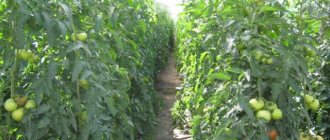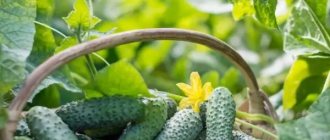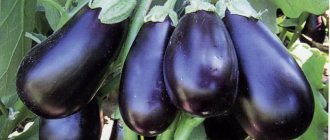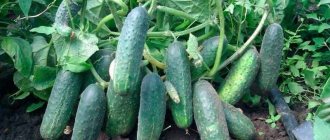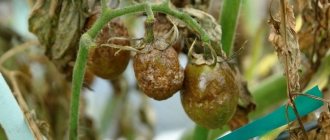What substances do eggplants need?
In order to fully develop and bear fruit, eggplants need a certain set of nutrients.
Micro- and macroelements necessary for eggplants:
- Nitrogen. Causes active growth of green mass. With a lack of nitrogen, the bushes lag behind in growth, the ovaries form slowly, and the ripening of fruits is delayed. If there is an excess of this element, eggplants “fatten”, the plants actively increase their green mass, and flowering becomes scarce.
- Potassium. Increases the plant’s immune abilities and resistance to temperature changes.
- Phosphorus. Promotes the development and strengthening of roots and ovaries. Accelerates fruit ripening.
- Boron, manganese, iron. They have a positive effect on the taste of fruits, promote the formation of flowers, and increase productivity.
The lack of one or another element can be determined by the leaves - they are more sensitive and delicate in eggplants than in other crops.
Signs of nutritional deficiency:
- The leaves have turned yellow at the edges, the growth of the entire plant has slowed down - there is not enough potassium.
- The leaves rise upward, the plant sheds flowers, the fruits do not develop - phosphorus is needed.
- The leaves are limp, first the lower ones turn yellow, and then all the rest. The plant is experiencing nitrogen deficiency.
Caring for eggplants in a greenhouse
It is advisable to grow eggplants in a greenhouse separately from other plants, positioning them in such a way that optimal temperature conditions can be created, as well as additional lighting on cloudy days.
Required temperature and humidity
We must try to create conditions such that the average daily temperature is between +24 and +28 degrees .
If the variety is resistant to temperature changes, then this indicator can be kept at a level from +18 to +24 degrees. In the case of such varieties, at higher temperatures, the flowers will begin to fall off, which will result in fewer ovaries. And at low temperatures (below +15 degrees) the development of the plant will stop.
On hot days, the temperature can be reduced by ventilating the greenhouse or watering the paths with cold water. You can also shade the sunny side.
The most suitable humidity during the growing season is 60-70% . During fruiting, it should be about 60% to prevent the appearance of fungal infections on overgrown bushes.
Watering rules
Young plants need to adapt after transplanting. Therefore, watering eggplants for the first time is carried out no earlier than after 4 days.
Important! Plants should be watered only at the root so as not to wet the leaves. Water can damage foliage.
You need to water with water whose temperature is not lower than +25 degrees . Otherwise, flowering begins later.
Lack of water leads to stopping the development of plants and shedding of ovaries. During the fruiting period, eggplants need to be watered every 3 days.
Watering must be done in the morning , and then mulch the ground near the bushes so that fog does not form in the greenhouse. The amount of water required depends on the soil. After watering, the soil should get wet 20-25 cm deep.
Fertilizer application
The formation of fruits in blueberries very much depends on the availability of nutrients in sufficient quantities. Therefore, it is imperative to fertilize the soil. Feeding is carried out up to 5 times per season.
Timing for feeding eggplant
When growing eggplants, even fertile soils need nutrition. After planting the seedlings in the ground, the crop is fertilized 3-4 times. On infertile soils, the frequency of fertilizing increases.
Fertilizing is applied based on the stage of plant growth, and not on the calendar and specific dates.
Eggplant fertilization schedule:
- After the pick. This is the first application of nutrition, which is carried out at the stage of growing seedlings. If seedlings are grown without picking, fertilizers - nitrogen and potassium - are applied when two true leaves appear.
- Before the transplant. Regardless of whether seedlings are to be planted in open or closed ground, they are fed 8-10 days before transplantation with nitrogen, potassium and phosphorus.
- After disembarkation. Feeding is introduced 2-3 weeks after planting, not earlier. Plant roots are not sufficiently adapted to the new environment and are unable to fully absorb nutrients. Fertilize with nitrogen, potassium and phosphorus.
- Budding. Carry out during the formation of ovaries or flowering. At least 10 days must pass after the last application of fertilizer. Fertilize only with phosphorus and potassium.
- Fruiting. Fertilize with phosphorus and potassium.
Mistakes when feeding eggplant seedlings
Beginner gardeners often do not adhere to the rules of fertilizing, so they cannot get a rich harvest. Here are the main errors:
- Expired drugs - fertilizers lose their beneficial properties after their expiration date.
- Root feeding solutions are not suitable for treating foliage.
- Fertilizers are applied immediately after transplantation - the root system is injured at this time and therefore cannot absorb nutrients.
- They don’t adhere to deadlines—the crop needs nutrition as it grows.
- Applying fertilizers to dry soil - the fertilizer solution burns the roots. It is imperative to fertilize after watering.
Watch the video! Care and fertilization of eggplant seedlings
With proper and timely feeding of eggplant seedlings, you can grow healthy and strong plants that will produce a rich harvest of tasty and large fruits. It is necessary to adhere to the terms and rules described in this article so as not to harm the plants. All fertilizers must be applied strictly according to the instructions.
Methods of fertilizing
Eggplants, like most crops, are fed in two ways - at the root and by spraying. Let's find out how these feedings are carried out and what is given priority.
Root
Most fertilizing of eggplants is carried out using the root method.
Features of applying fertilizers at the roots:
- Fertilizers are given in the form of solutions.
- Fertilizing is combined with watering to prevent burns to the roots. First, water the plants, and only then pour out the dissolved fertilizers.
- When applying nutrition, do not allow the solution to come into contact with the above-ground parts of the plants.
- The best time to apply fertilizer at the roots is morning or evening.
Foliar
Foliar feeding is used if a quick effect on eggplant bushes is necessary.
Features of foliar feeding:
- Fertilizer is supplied to plants by spraying.
- Solutions for foliar feeding should have half the concentration of analogues for application under the root.
- It takes approximately 1 liter of dissolved fertilizer to process one adult plant.
Not all fertilizers are used for foliar feeding of eggplants. You can spray plants with boric acid, ash solution, Agricola and Kemira.
How to properly feed eggplants
Fertilizer application has its own characteristics:
- There are three ways: embedding the mixture into the soil in dry form, watering or spraying with a solution.
- It is important to water the plants before applying any fertilizer.
- For spraying, a less concentrated solution is prepared, and it should be carried out in the morning or evening hours, when there is no exposure to scorching sunlight. This is foliar feeding.
- When applying liquid fertilizer, it should be poured strictly at the root, avoiding contact with the leaves. If this happens (especially when applying nitrogen-containing and phosphorus fertilizers), rinse the substances from the leaves with clean warm water as quickly as possible.
- Both ready-made mixtures of complex mineral fertilizers (follow the instructions) and organic matter prepared according to the recommendations of experienced vegetable growers are used as fertilizing. It is also better to alternate them.
What fertilizers are used?
Eggplants are fed with different types of fertilizers, which differ in their composition, principle of action, cost, environmental friendliness and other properties.
Organic
Organic fertilizers have a positive effect not only on the development of eggplants, but also on the condition of the soil.
The most popular organic fertilizers:
- Manure solution. Manure is mixed with water in a ratio of 1:10, bird droppings - 1:20. The solution is infused for one week.
- A solution of manure and grass. The crushed weeds are placed in a large container, a solution of manure and water is poured in (1:1:10). Add 50 g of wood ash to 1 liter of solution. They insist for one week. Before use, dilute with water (1:3). For each eggplant bush - 1 liter of solution.
It is not recommended to feed vegetable crops with fresh manure - it is too concentrated and will cause excessive growth of green mass. In this case, fruit formation will be inhibited.
Eggplants can also be fed with humus, compost, ready-made organic fertilizers - Bioton, Gumi-Omi and others.
Mineral
The main feature of mineral fertilizers is their high concentration, and a serious drawback is the ability to accumulate in plant fruits.
When choosing a mineral fertilizer, take into account the following factors:
- plant growing stage;
- needs for a specific element - determined by the appearance of the plant;
- soil characteristics.
The most effective and affordable fertilizers:
- Ammonium nitrate. Used as nitrogen fertilizer for seedlings. It can be combined with potassium sulfate - if nitrogen-potassium nutrition is required, with phosphate rock - if nitrogen-phosphorus nutrition is needed. Ammonium nitrate is mixed with superphosphate immediately before application. Fertilizer must not be combined with urea.
- Urea (urea). Used to add nitrogen. Foliar application is allowed. It is advisable to apply separately from other mineral fertilizers. Urea can be added to the manure solution to increase the nitrogen content, but mixing it with ash is not recommended.
- Ammonium sulfate. Suitable for spring feeding, as it contains a lot of nitrogen in an easily digestible form. It is prohibited to combine with potassium nitrate and superphosphate. Mixing with manure is allowed. Ammonium sulfate should be added to the manure solution immediately before application to the soil.
- Potassium nitrate . Used during flowering. Contains potassium (13%) and nitrogen (45%), therefore it is not suitable for application at the stage of fruit ripening. Do not mix with other mineral sources of nitrogen, manure or ash. You can combine it with superphosphate, but only before adding it to the soil.
- Superphosphate. An excellent source of phosphorus, which is used only on soils with normal acidity. On acidic soils, monosodium phosphate or monopotassium phosphate is used.
- Potassium sulfate. Effective potassium supplement. Can be applied at any stage of the growing season. It is allowed to be combined with any fertilizers containing nitrogen; it can be added to manure, ash, and superphosphate. Dissolved potassium sulfate can be added to phosphate rock, but the mixture must be used immediately and cannot be stored.
Complex
Complex mineral fertilizers contain all the substances and microelements necessary for the development of eggplants.
The most popular complex fertilizers:
- "Kemira Universal";
- "Ideal";
- "Agrocola-forte" and others.
When feeding eggplants with complex fertilizers, it is important to strictly adhere to the dosage, since an excess of nutrients is just as harmful to plants as their lack.
What do eggplants need?
Like other nightshade crops, eggplants are extremely susceptible to deficiencies of the following microelements:
| Participation of minerals in the growth process of eggplants | |
| Element | What is it needed for |
| NITROGEN | Affects plant growth. If the quantity is insufficient, the bush grows slowly and sluggishly, which directly affects the fruits. |
| PHOSPHORUS | Necessary for proper development of the root system. It also affects the formation and appearance of ovaries and the speed of fruit ripening. |
| POTASSIUM | Important for the formation and growth of eggplant fruits. In the plants themselves, it increases resistance to various diseases and sudden temperature fluctuations. |
| MANGANESE, IRON and BORON | Improves fruit quality and crop yield. |
Mineral fertilizers you can use:
- Superphosphate - fertilizer has a balanced composition of nitrogen, potassium and phosphorus.
- Nitrophoska - has a composition similar to superphosphate.
- Ammonium sulfate – includes nitrogen and sulfur. Not recommended for fertilizing on acidic soils.
- Potassium nitrate - fertilizer contains nitrogen and potassium.
Organic fertilizers are also used to feed eggplants: mullein, bird droppings, rotted manure and compost. Moreover, all of them are pre-infused, after which they are used in diluted form. Fresh manure is not used for fertilizer - it contains too much nitrogen.
Folk remedies
To fertilize eggplants, many gardeners use folk remedies. They are available, do not require large expenses, and, unlike “chemistry,” do not lead to the accumulation of harmful substances in fruits.
How to prepare fertilizer according to folk recipes:
- Ash. This is the most common folk remedy, which is applied both independently and as part of various supplements. How to prepare ash solution:
- Dilute 500 g of ash in a bucket of water;
- first fill the ash with 2 liters of hot water, and then add cold water, bringing the volume to 10 liters;
- leave for 24 hours;
- filter the infusion and apply to the root;
- for foliar feeding, double the amount of water.
- Iodine. This pharmaceutical preparation is used to treat eggplant seedlings. It not only saturates plants with useful microelements, but also destroys pathogenic microorganisms. How to use iodine:
- Dissolve 2 drops of regular iodine in 3 liters of water;
- Pour the resulting solution under the roots of the seedlings.
- Yeast. Can be used:
- Regular yeast. Dissolve 1 kg of yeast in 5 liters of warm water. Leave for 24 hours. Before use, dilute with water in a ratio of 1:10.
- Dry yeast. Dissolve one sachet in a bucket of water. Add 2 tbsp. l. sugar so that the solution ferments more actively. Leave for 2 hours.
- Banana solution. This fertilizer saturates plants with potassium. Procedure:
- fill the skins of 2-3 bananas with water (3 l);
- leave banana peel for 2 days;
- water the plants with a filtered solution.
- Herbal infusion. It is prepared from nettle, dandelion, plantain, and lawn grass. How to prepare green infusion:
- mix the crushed herbal mass with water (1:2), cover with a lid and place in the sun to enhance fermentation;
- after a week, strain the infusion and use it for root feeding, diluting it with water 1:5;
- Application rate: 1 liter of solution per bush.
- Compost tea. This is a natural fertilizer that increases soil fertility and improves the taste of fruits. To prepare this fertilizer you will need a compressor. How to prepare the composition:
- in 3 liters of water, dilute 10 ml of any sweetener - syrup, molasses, fructose, sugar, kvass wort;
- add 70 g of mature compost;
- place the compressor tubes in water and turn on the aeration system for about a day;
- Use the prepared tea within 4 hours after preparation.
- Bread-yeast based solution. This universal remedy increases the immunity of plants and stimulates their growth. Procedure for preparing the solution:
- mix the ingredients - yeast, ash, grass clippings, fluff lime, bird droppings and black bread;
- let the mixture stand for 6-7 days, then dilute it with water and water the plantings.
How to water if the eggplant seedlings are stretched out?
Eggplant seedlings often stretch out due to lack of lighting. And in order to improve the condition of the plants, first of all, you will need to move them to a brighter place, or install a phytolamp next to them.
Only after this can the plants be fed with special retardants that slow down the growth of stems and shoots. These include drugs:
- "Athlete";
- "Strength";
- "Stocky".
The drugs must be diluted strictly according to the instructions.
Fertilizer application scheme
Fertilizers are given to eggplants according to a certain scheme. During each growing season, the vegetable receives the nutritional elements it needs.
Feeding eggplant seedlings
To grow strong and healthy eggplant seedlings, you have to feed them several times.
How to feed seedlings:
- First feeding. It is carried out 2-3 weeks after emergence. Dilute manure (1:10) and ash (1 tbsp) in water. Add 4 liters of solution per 1 sq. m.
- Second feeding. It is carried out two weeks after the first. Dissolve 70 g of superphosphate and 25 g of calcium chloride in 10 liters of water. For 1 sq. m add 2 liters of solution.
- 7-10 days after the pick. If you are picking seedlings, then after transplanting, add a weak solution of manure - 1 tbsp. l. for 10 liters of water. Or fertilize the seedlings with urea - put 1 tsp on a bucket of water. facilities. Add wood ash - 1 tsp. for one individual pot.
You can also use purchased products. Eggplants can be fed, for example, with Kemira Universal, Mortar, and Kornevin. Pour drug solutions at the root, avoiding contact with the leaves.
Top dressing after planting in open ground
Fertilizers are applied 12-14 days after planting the seedlings in a permanent place.
The task of the first fertilizing after transplantation:
- activate plant growth;
- adapt seedlings to new conditions;
- promote the development of the root system.
You can use complex fertilizers, “Kornevin”, “Solution”, etc. – they not only promote plant growth, but have a positive effect on the formation of ovaries.
The first feeding in a permanent place should contain nitrogen, phosphorus and potassium.
How to feed eggplants:
- mix the ingredients - superphosphate (80 g), urea (30 g) and potassium nitrate (30 g);
- dissolve the mixture in 10 liters of water;
- Water the plants at the roots with the resulting solution.
At the initial stage of cultivation, before flowering, you can also add:
- yeast feeding;
- boron, iron, manganese (for flowering).
Fertilizer during flowering
At the flowering stage, eggplants most need potassium and phosphorus fertilizers. You can apply mineral fertilizers, but experienced gardeners prefer to use organic matter at this stage - manure or infusion of herbs.
Options for feeding eggplants during flowering:
- Nettle infusion. It contains calcium, nitrogen and potassium in an easily digestible form. Instead of nettle, you can use other herbs. Dilute fermented solutions with water before use. The norm for one bush is 1 liter of infusion.
- Mullein solution. Dilute 1 kg of mullein in a bucket of water. Add 100 g of wood ash. Use 1 liter of solution for each plant. Instead of mullein, you can use bird droppings, but you need to take half as much of it - 500 g per bucket of water.
- "Gumi-Omi." It is a safe substance used in organic farming. Contains composted chicken manure, as well as balanced amounts of P, N, K, sodium humate, trace elements - copper and boron.
- Recipe 1. Dissolve potassium sulfate (15 g), urea (15 g) and superphosphate (30 g) in 10 liters of water.
- Recipe 2. In a bucket of water, dilute 10-15 g of superphosphate, potassium salt and ammonium nitrate.
During the period of fruit ripening
As the fruit begins to ripen, eggplants most need potassium, phosphorus, boron and iron.
Feeding options during fruiting:
- Superphosphate. Dilute 40 g of fertilizer in 10 liters of water.
- Potassium sulfate. Dilute 1 tbsp. l. drug in 10 liters of water.
- Chicken droppings. Dilute 1 kg of litter and 4 tbsp in 10 liters of water. l. nitroammofoski.
Water the eggplants at the roots with the resulting solutions - 1 liter per plant.
Many gardeners, at the fruiting stage, prefer organic matter and folk recipes. So, in particular, when the fruits ripen, it is useful to feed eggplants with an infusion of chopped grass, which is fermented for 2-3 days.
Rules for fertilizing eggplants
Stages of eggplant development: (1 - young plant (seedling); 2 - flowering branch; 3 - seed; 4 - 6 - fruits).
It is necessary to fertilize the crop correctly. Even the best composition purchased or prepared by yourself will not give the desired result if the plant is not fed correctly. In addition, there is a danger that such products will simply burn the eggplants, and then you will have to start planting again.
Therefore, in order to keep your harvest safe and sound, it is worth remembering the following points:
- Liquid fertilizers should be used only if it is not hot outside.
In order for them to be of any use, the soil and beds must be well watered, and it is even better to carry out such fertilizing after rain. True, this is the case if the eggplants grow in the garden and not in the greenhouse.
- If root feeding is carried out, then all solutions are poured only under the root. The substance should not touch the leaves, much less the fruits themselves, as this can cause burns to the plant.
You should know that the leaves of a crop are an indicator of its condition. If they begin to wilt or dry out, it means that the eggplant lacks nutrients. In order not to guess, it is best to choose complex fertilizers, then they will fully saturate the plant with all the substances it needs. A strong concentration is used for the roots, and a weak concentration is used for the leaves.
All these little tricks help save the harvest. If you don’t want to prepare fertilizer yourself, you should buy certified products. The cheaper the fertilizer, the more likely it is filled with chemicals that can seriously burn the plant. Don’t be shy about asking the seller for documents to confirm quality. And if he refuses this request, then you should look for another store with fertilizers, because your own harvest is more expensive.
Feeding rules
To achieve the expected effect from fertilizing, it is necessary to follow the principles of eggplant nutrition.
Eggplant nutrition rules:
- During the season, eggplants are fertilized several times. Vegetables need fertilizing at all stages of the growing season - from seedlings to the ripening period.
- Good fruiting is possible only on properly fertilized soils.
- The greatest effect from fertilizing can be achieved by alternating organic and mineral fertilizers applied in accordance with the needs of the plants at each specific stage. Organic matter not only nourishes plants, but also makes the soil loose. Mineral, due to their high concentration, allows you to quickly saturate eggplants with the necessary elements.
- Foliar feeding is rarely used. Eggplants, having delicate leaves, do not tolerate spraying with aqueous solutions. Such treatments are carried out only when absolutely necessary and on depleted soils.
- All fertilizers are applied in strict dosages. Exceeding doses has a detrimental effect on plants.
- If a shortage or excess of one or another element is detected, its content is immediately adjusted. So, if there is an excess of nitrogen, the beds are watered with a solution of ash or superphosphate, and if there is a deficiency, urea or mullein solution is promptly added.
- On poor soils, fertilizing is carried out every 10 days.
- When applying fertilizers at the roots, do not allow the compounds to get on the leaves.
For information on feeding eggplants, watch the following video:
Proper feeding of eggplants is the basis for high yields and large fruits. Timely applied fertilizers not only ensure the full development of plants, but also help them cope with environmental challenges.
0
0
Copy link
How many times and when to feed eggplants
Fertilizing will benefit eggplants if everything is done correctly (concentration of the substance) and in a timely manner (replenishing the deficiency of elements required at certain stages of development).
The first fertilizing should be done when the young plants are sufficiently strong. This is done at the “seedling stage”. Apply any complex mineral fertilizer, preferably with a predominance of nitrogen, which will enable the seedlings to increase green mass. In this case, after transplantation, the eggplants will take root faster and begin to grow.
The second feeding is necessary after transplantation to a permanent place of growth (greenhouse or open ground). To help the root system develop successfully, take root in new conditions and strengthen the immune system, apply potassium-phosphorus fertilizer.
The beginning of flowering is time for the third feeding . Eggplants produce a lot of barren flowers, so you should do your best to increase the number of flowers capable of bearing fruit in the future.
So the fruits have begun, but do not neglect feeding . Be sure to feed a fourth time during the fruiting period, which will have a positive effect on the size of the fruit. Below we will tell you more about everything in order.
Organic fertilizers
You can replace mineral fertilizers with organic ones (manure from farm animals and birds, humus, wood ash, compost, herbal infusion, etc.). It is more difficult to calculate the amount of organic matter, but it is absorbed much better and faster by growing eggplants and is less dangerous to humans.
Compost
After harvesting, the remains of plants and weeds remain in the beds. They are placed in a hole and left to rot until spring. For the soil mixture for seedlings, two-year-old compost is used; in a year it will not have time to rot, the heat generated can destroy the seedlings.
Wood chips rot for at least 3 years. The larger they are, the longer the decay process. Rotted sawdust can serve as vermicompost; it is added to the soil mixture for seedlings. This additive takes nitrogen from the soil.
Compost is also made from fallen leaves from trees. It rots like herbal compost.
Humus
Rotted cow manure is used clean without bedding. In mixed mullein with urea, after rotting, more nitrogen remains than in pure manure. Humus is used for two years; in fresh humus, undigested plant seeds germinate and seedlings die.
An excess of organic matter will lead to lush foliage and there will be few ovaries.
Vermicompost
Worms feed on humus or compost; the product of worm processing is a good raw material for fertilizing blue ones. Annual organic matter is suitable for the process.
Ash
The remains of plants and herbs are burned and useful fertilizer is obtained. Plant ash serves to maintain soil fertility. It contains all the elements necessary for eggplants. Ash serves as a growth stimulator when soaking seed material and neutralizes soil acidity.
Feeding eggplants with iodine
Iodine, due to its disinfecting properties, will be very useful for eggplant seedlings. It will help cope with pests and pathogenic microorganisms contained in the soil. To do this you need:
- prepare a solution by adding 2 drops of iodine tincture to 3 liters of water;
- water the seedlings at the roots.
Yeast nutrition for eggplants
Yeast will have a positive effect on plant growth, improve the condition of the eggplant soil and kill many harmful parasites. To feed eggplants with yeast you need:
- dissolve 1 package of wet yeast and 12 g of granulated sugar in 1 liter of warm water;
- leave the mixture for two hours;
- dilute the solution with water in a ratio of 1:10 and water the seedlings.
It is recommended to fertilize in this way once per season.
Fertilizing with banana solution
To saturate eggplant seedlings with potassium, you can use banana infusion. To do this you should:
- pour the peels of 2 - 3 bananas into 3 liters of water;
- leave the mixture for 48 hours;
- filter the solution and water it.
Eggplants have started. What to feed?
How to feed eggplants during the ovary period - folk remedies
During the period when fruiting begins, you should try to ensure that the ripening eggplants gain weight: at this time it is important to feed them with potassium fertilizers; in cold, damp summers this is especially important. We offer several feeding options, the effectiveness of which has been experimentally tested:
- In 10 liters of warm water, dissolve two tablespoons of superphosphate and 1 tbsp. l. potassium salt.
- Or dissolve 1 tablespoon of potassium sulfate in the same volume of liquid;
- A solution of 2 tablespoons of nitroammophoska is also suitable;
- you can take 1 tbsp urea, 2 tbsp. l. superphosphate and add 1 tbsp. l. potassium chloride.
The consumption of any working solution is a bucket per square meter of planting.
Remember: after mineral fertilizing, harvesting cannot be done for 3 weeks.
At this time, fertilizing based on a solution of mullein or chicken droppings is also ideal.
How to feed eggplant during flowering
How to feed eggplant during flowering
For cultivated plants, fertilizing is simply necessary. In order for flowering to be successful, fertilizer should be applied approximately three weeks after transplanting to a permanent place of growth. By this time, flowers appear, and the plant is maximally predisposed to absorb nutrients.
It is useful to feed eggplants during flowering with complex mineral fertilizers. Suitable, for example, are “Harvest”, “Solution” and others similar. They will supply the plants with the necessary amount of nutrients and contribute to the further appearance of the ovary.
Of the fertilizers that you can prepare yourself, give preference to nitrogenous ones. Organic products made from fresh green grass are suitable.
Herbal infusion is not difficult to prepare:
- We place a large barrel in a sunny area, fill one third with green mass (this can be nettles, dandelions, weeds collected from the area), fill it to the top with water, preferably cover it with a lid.
- Let it all ferment for 7 days.
- Dilute the concentrate 1:10 with water and water the plants: a bucket of solution per square meter of planting.
Complex organic fertilizer for eggplants during flowering
The following mixture contains a whole range of useful elements:
- Pour about four kilograms of green mass, 5 liters of fresh mullein and 200 g of wood ash into a 50-liter barrel.
- Add water to the top, cover with a lid and leave in a warm place for 7 days to ferment.
- Before use, dilute the concentrate with water in a ratio of 1 to 3, add 1 liter of working solution to each plant.
Rules for root feeding of blueberries
- Alternate mineral and organic preparations (recipes, formulations).
- Do not exceed the application rates indicated on the packages and in the given recipes, since with an excess of organic matter, plants excessively increase green mass (to the detriment of fruiting), and the presence of excess mineral compounds in the soil leads to the accumulation of nitrates in fruits.
- Fertilize only after scheduled watering of eggplant plantations (on the same day or the next).
- Plan your event for early morning or evening.
- Gently pour the solution under the root of each eggplant bush.
When foliar feeding is vital
In some cases, foliar treatment is still necessary. For example, when the plant is completely weakened and lacks microelements. In this case, the fertilizer concentration needs to be diluted several times less than for root feeding. Otherwise, you can burn the leaves of the crop.
When is foliar feeding useful:
- in case of diseases and pests;
- during humid summers, when rains wash away nutrients from the soil;
- when flowering;
- with a poorly developed rhizome;
- with general weakness of plants;
- to increase productivity.
Foliar feeding is done by lightly spraying the plants so that small droplets remain on the leaves.
Please note: fertilizers for eggplants are prepared only in warm, purified water. The temperature of the finished solution should be 22-25 degrees. Each bush requires 1 liter of feeding.
Why is foliar nutrition so beneficial? First of all, this way nutrients reach plant organs faster. You will have to wait a long time for the result from the root, while the leaf immediately absorbs microelements, and the synthesis process occurs faster.
The use of spraying is advisable during the formation of ovaries. It happens that this process is slow and the flowers begin to fall off. Treatment with boric acid or magnesium sulfate helps stimulate flowering. The easiest way is to use ready-made products (Agricol, Kemira universal), which are used to spray the plantings.
By the way: you can increase the number of ovaries manually, that is, gently shake the bushes, tapping the stem.
Mineral fertilizers
Ready-made complex fertilizers are available for sale, in which the chemical elements are in a balanced form. You can fertilize eggplants with the following mineral fertilizers:
- Superphosphate, which simultaneously contains 3 important elements: phosphorus, nitrogen and potassium.
- Nitrophoska or nitroammophoska, which have the same composition as superphosphate, but differ from it in the ratio of elements.
- Ammonium sulfate, which contains nitrogen and sulfur. This fertilizer cannot be used on acidic soils, as it acidifies them even more.
The exact amount of synthetic fertilizers required for the normal functioning of eggplant bushes can be calculated by following the instructions for use included with the fertilizers.
How to find out about a lack of mineral elements?
The plant itself can signal a lack of certain microelements:
- pale foliage - lack of nitrogen;
- purple coating – lack of phosphorus;
- brown spots on the foliage - potassium is needed;
- stripes on leaves - calcium will help;
- variegated leaves - not enough magnesium, you can water it with a weak solution of potassium permanganate.
You need to fertilize the land in the fall, add organic matter - 5 kg of manure per square plot, and dig up the garden. By spring, the area will be ready for planting eggplants.
How to feed eggplants during the fruiting period in open ground
Plants grown in open ground are absolutely not protected from the vagaries of the weather. For normal development and growth, resistance to diseases and pests, it is necessary to regularly add nutrients.
Let's consider a couple of feeding options:
- Pour 0.5 liters of Effekton fertilizer into a 100 liter barrel, fill the rest of the space with water, stir and add 1 liter of working solution to each bush.
- We prepare a dry mixture: 5 kg of chopped greens (garden weeds, nettles, dandelions), a five-liter bucket of fresh mullein and half a glass of wood ash. Fill with 50 liters of water and let it brew for a few days and ferment. Then pour about 1 liter of solution under each bush and water with clean warm water.
Even when grown in protected soil (in a greenhouse), the need for fertilizing does not disappear. Most often, in the conditions of central Russia, eggplants are grown in a greenhouse.
Foliar feeding of eggplant for ovary and abundant fruiting
How to feed eggplants for fruiting
This means spraying plants from a spray bottle with the following solution:
For 10 liters of water, take 2 grams of magnesium sulfate and boric acid. This feeding can be carried out throughout the season: in the early stages it will protect the leaves from falling, and during flowering it will stimulate the growth of female flowers that produce an ovary.
Please note that eggplants should be planted in previously prepared (fed) soil. The first time eggplants are fed while still in seedlings, then fertilizers should be applied at all key stages of development: after transplantation, during flowering, the beginning of fruit set and during fruiting. With systematic fertilizing, a rich harvest is guaranteed.




